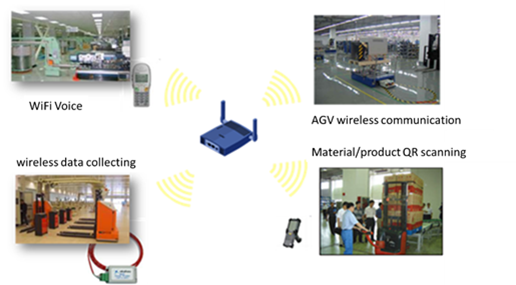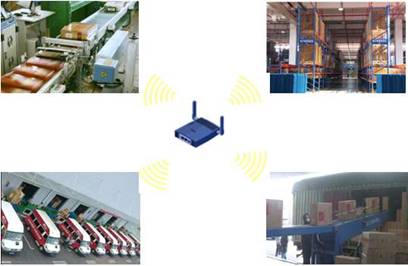Applying Wireless in the Tobacco Industry
16-05-20181.Overview
After over ten years of efforts, the digitalization of Chinese tobacco enterprises has taken shape, evolving from stand-alone and local system applications towards networked, integrated, intelligent applications. Management information systems have also begun to play an important role in the industry’s economic development. Most tobacco enterprises have now constructed basic networks capable of supporting the operation of various application systems, and greatly improved their production and sales efficiency. But these existing basic networks are often limited in coverage and insufficient to support the requirements for more real-time, richer, and more extensive information collection and interaction that the further development of digitalization in the tobacco industry will bring. Existing basic networks are not fully up to the task of promoting further efficiency gaining in productions and sales. The introduction of WLAN technology will be critical to this task, and in increasing the overall “smartness” of the tobacco industry.
WLAN technology can provide reliable, high-speed network access over large coverage areas, and ensure timely data exchange – now at speeds matching wired networks if 802.11ac technologies are adopted. Thus WLAN can support most of the same applications as existing wired networks, and has become a staple of tobacco industry digitalization.
WLAN solutions are therefore important components of H3C's leading New IT integration solutions, which are tailor-made to satisfy the tobacco industry’s requirements for instant data interactivity and seamless network connectivity in the logistics and OA areas, supporting wireless applications such as barcode scanning, and location, voice, and wireless monitoring services. The main areas covered by these H3C WLAN wireless solutions are production, logistics, and OA solutions.
2.Wireless Production

Wireless applications are widely used in the field of tobacco production. But in addition to providing traditional barcode scanning capabilities in factories, WLAN technology can also provide seamless voice services, flexible data collection functionality, and automated guided vehicles (AGV) services.
Wireless scanning technology frees barcode scanning from the limitations of traditional cables, supporting real-time scanning of raw materials and finished or semi-finished products, and transmission of scan results to CIMS and ERP systems, providing accurate production status information in support of production decision making. All H3C WLAN barcode scanning solution products have received Wi-Fi Alliance compatibility certification, ensuring their perfect interoperation with mainstream barcode scanning devices.
Wireless-based data collection allows flexible sensor installation unhindered by cabling considerations, and creates the potential for mobile data collection, which can greatly improve the efficiency of data collection. In this area, H3C can provide WLAN-based Real Time Location Systems (RTLS) solutions, with sensors not only collecting environmental data such as temperature and humidity, but also providing the locations of data collection points – a capability making for more convenient and accurate mobile data collection.
Powerful VoIP technology can also be tightly integrated with OA systems, and has thus seen wide adoption by enterprises, with Wi-Fi-based VoIP solutions increasing the mobility of this application while maintaining its powerful functionality. In factories and campuses, Wi-Fi voice solutions can provide the ability to communicate anytime, anywhere greatly improving the efficiency of communication. H3C’s VCX series IP voice solutions can interoperate with flexible partner-provided Wi-Fi voice terminals, and H3C WLAN products incorporate technology fully supporting the 802.11e protocol and QoS for voice services. H3C WLAN solutions also support fast roaming, eliminating voice service interruptions during roaming.
To suit the rigorous factory environment, the H3C WLAN solution product range includes toughened products, resistant to high levels of dust, electromagnetic interference, humidity, and temperatures, thus maintaining WLAN stability in factory environments where these are factors are present.
3.Wireless Logistics

Logistics prioritizes timely and accurate delivery of goods. While tobacco logistics concerns are mainly concentrated on the tail links of the tobacco production/marketing chain, they remain critical to these links. The centrality of distribution, discreteness of customer, and importance of security which increase the complexity of tobacco logistics, reduce the opportunities for innovation in that area. Cigarettes are a valuable commodity, and thus there must be reliable technical methods for goods tracking and scheduling facilities for checking their location and delivery status.
Wireless barcode scanning technology provides an excellent method for checking the status of goods during warehousing, loading, unloading, and storage, and has thus been widely adopted in tobacco logistics. However, another important task – real-time goods tracking – has yet to see the adoption of a single dominant solution. The tracking technologies currently used in tobacco logistics include LTE location, GPS location, and RFID location. But these have drawbacks: separate location systems are required for outdoor and indoor use, and in large warehouses and or other large areas, the number of RFID readers required for good coverage may be impractical.
H3C's WLAN-based Real-Time Location System (RTLS) solution can share its network with barcode scanning, OA, and Wi-Fi VOIP systems, and does not require deployment of special reading devices in order to conduct real-time location of vehicles and pallets. The RTLS calculates device location based on the Received Signal Strength Indications (RSSI) of wireless devices within a specified area, achieving WLAN-based location accuracies of up to 2 meters. And unlike LTE and GPS location, RTLS location operates in three dimensions, and is capable, for example, of accurately locating items on different levels in a warehouse.
In addition, the H3C wireless location solution can integrate GPS and RTLS location data. Using of GPS and WLAN dual-mode tags, it is possible to use WLAN for location within factory grounds, and GPS wireless location outside the grounds, thus allowing one set of GIS sensors to perform unified logistics tracking.
4.Wireless OA
In the tobacco industry, the digitalization of Open Access Networks (OANs) is also critical. The OAN system must allow easy access to applications, data resources and mail, processing of emails and documents, and connection to CIMS and ERP systems, so that production, sales and other situations can be properly understood. In the OA system, WLAN is complementary to the wired network, allowing continued access in areas – such as meeting rooms, reception rooms, etc. – where wired network deployment is limited, and thereby improving office efficiency. Even in areas such as offices where wired networks are fully deployed, the WLAN provides greater flexibility, giving users access to network resources without restriction due to network port placement or availability.
But while wireless connections make OAN systems convenient, they also entail potential security risks. Due to the openness of the transmission medium, WLAN signals cannot be tightly restricted to any target area, and users outside the target area may also be able to access them, creating a major security issue. Security measures are thus very important for OAN systems.
H3C’s WLAN solution addresses WLAN security problems in two main ways. First, the solution supports the international standard 802.11i comprehensive and secures encryption mechanism, including the WEP, TKIP, and AES encryption algorithms/protocols, with key length of up to 256 bits to prevent cracking. Second, the solution also supports the Chinese Wireless LAN Authentication and Privacy Infrastructure (WAPI) standard, whose adoption of China's homegrown elliptical encryption algorithm, and support for two-way authentication, make for greatly improved WLAN security.
H3C WLAN also supports the End User Admission Domination (EAD) solution, which checks users’ operating system for patches and anti-virus software after user identity authentication is complete. Only users who meet security requirements are allowed to access network resources.
With comprehensive encryption and authentication mechanisms and EAD, the H3C WLAN solution can ensure network resources’ security while providing convenient access to authorized users – two key advantages which have led to its broad recognition and adoption.
5.Summary
An IToIP solution, H3C’s WLAN solution forms an important part of H3C's integrated "digital tobacco" communications platform, enabling integration of hardware, security, and management in the tobacco industry, and providing fast, flexible, reliable and secure network access for logistics, production and operations. As the digitalization of the tobacco industry progresses, H3C’s WLAN solution’s unique advantages mean that it in future, its adoption can only grow.
You can find excellent H3C partners, or you can become one of them to build a
partnership with H3C and share success together.

